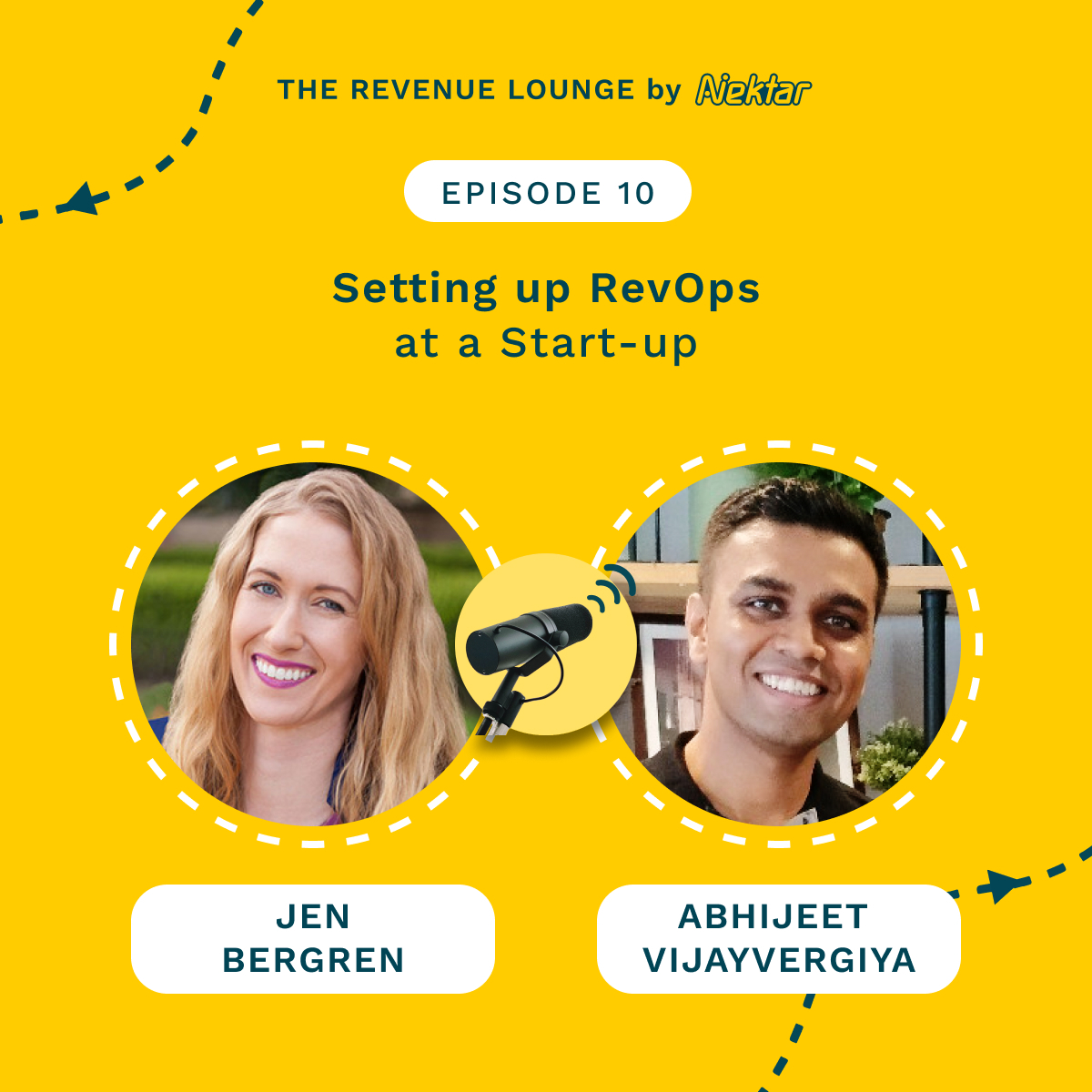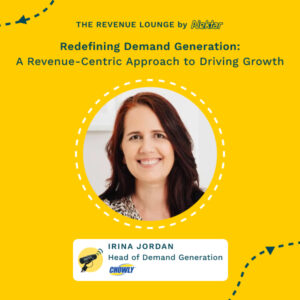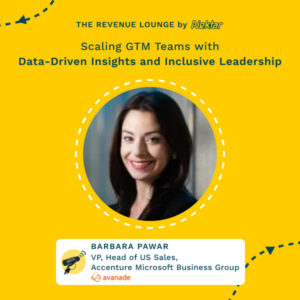Ep #4: Moving from a Siloed GTM Structure to a RevOps Structure ft. Dan Jiao
April 26, 2023
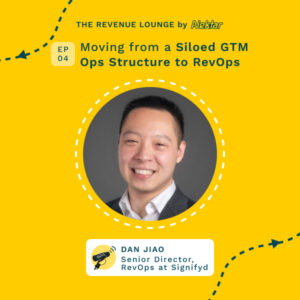
About
The Revenue Lounge
The podcast covers stories from leaders across RevOps, Sales, Customer Success, GTM, Data and Marketing about what drives these functions and what advice they would share with our listeners. With 3 seasons recorded, the podcast currently features 50+ enterprise leaders in the B2B SaaS domain. Tune in to hear from the best in the business
Welcome to Season 2 Episode 4 of The Revenue Lounge Podcast by Nektar.ai – A series of interviews with top Revenue Operations leaders on what drives the function and what keeps them going!
Episode Host – Abhijeet Vijayvergiya
https://www.linkedin.com/in/abhijeet-vijayvergiya-2571056/
Episode Guest – Dan Jiao
https://www.linkedin.com/in/danjiao/
Podcast Details:
Podcast page – https://bit.ly/3UznQ4U
Spotify – https://open.spotify.com/show/3DUOqnTpPOJ2xbyl7HdgN3
Google Podcasts – https://podcasts.google.com/u/0/search/the%20revenue%20lounge
Apple Podcasts – https://podcasts.apple.com/in/podcast/the-revenue-lounge/id1645044872
Episode Details:
According to Gartner, 75% of the highest-growth companies in the world will deploy a RevOps model by 2025. Many organizations are realizing the value that a revenue operations functon can bring to their revenue, especially in an uncertain market.
A lot of RevOps leaders we have spoken to over the last year have highlighted how having a RevOps function is critical to survive any kind of uncertainty and running a right GTM ship.In this episode, you will hear the story of a company that moved from a siloed GTM Ops structure to a RevOps structure.
Let’s hear it from Dan Jiao, Senior Director of RevenueOperations at Signifyd, on the BTS story of this transition, advantages and learnings for the rest of us to follow. Dan is a data-driven business leader with a track record of success in sales, go-to-market (GTM), operations, strategy, and management.
Want to learn more about Nektar?
Talk to our team – https://bit.ly/3MishjZ

[00:00:00] According to Gartner, 75% of the highest growth companies in the world will deploy a RevOps model by 2025. Many organizations are realizing the value that a RevOps function can bring to their revenue, especially in an uncertain market like today. A lot of RevOps leaders I’ve spoken to over the last year have spoken about how having a revops function is critical to survive any kind of uncertainty and running a tight and capital efficient GTM engine.
This excites me to talk about today’s topic as we will be hearing the story of a company that moved from a siloed GTM structure to a revops structure. Let’s hear it from Dan Jiao, senior Director of Revenue Operations at Signifyd on behind the scenes story of this transition, advantages and learnings for the rest of us to follow.
[00:00:58] Dan is a data-driven business leader with a track record of success in the sales go to market operations, strategy, and management functions. Dan, thanks for joining us today. We can start with your introduction.
Yeah, thanks Abhi. Appreciate you having me on the podcast. My name is Dan Jiao. I am the Senior Director of Revenue Operations here are Signifyd. Signifyd is in e-commerce fraud prevention platform. We essentially help the likes of Walmart or Samsung with improving good customer transactions when you buy things online or as well as with preventing fraud and abuse for them.
Here at Signifyd, we are really new to Revenue Operations, but I started taking over that team about a few months ago, and everything from marketing processes, sales processes, And customer success CS processes roll up to my team.
[00:01:47] We focus on everything from process optimization to the data for the customer buying journey, as well as like tools, systems, and analytics that support infrastructure of everything altogether.
Yeah, very interesting. So there’s a lot to chat about. Dan, and I love your story into how you got into Revops.
[00:02:05] I understand you are a chemical engineer, so it’ll be great for you to walk us through your journey, from being a chemical engineer, you became the rev ops lead.
Yeah, for sure. Like many people, revops is definitely always, we all have our unique paths for how we get there. I started my career off as an engineer.
[00:02:22] It’s what I went to school for specifically. I studied chemical engineering and I actually worked a few years in the semiconductors and chemicals industry a couple years after graduating college. Essentially did everything from like kind of bench related work to different engineering process, scale up work, and I first made my transition to B2B SaaS, actually not in like a revenue operations or sales operations path, like many people might go.
[00:02:47] I had more of a trajectory where I started off in sales. And I figured it was a good way for me to learn the industry I was joining. I was working at a company prior to Signified for a number of years that also did something similar with like fraud [00:03:00] prevention. And you know, I’m a really naturally competitive person too, so I just felt like sales coupled with, you know, being competitive, being very hungry to learn was a good place to start.
[00:03:11] It got really close to the customer, started understanding how they purchased, why they purchased, and. Part of that too allowed me to get exposure to a lot of things related to Salesforce, some of the processes for our sales cycle, our best practices in documenting playbooks. One of the things I really enjoyed was starting to also teach other people and enable them on some of the things that were making me really successful as a seller at the time.
[00:03:37] And then, you know, as I grew my career at that company, I also grew from, you know, being an account executive to being in sales management and actually getting the opportunity to move over to Singapore, where obviously that’s how we met was being able to open an office. And that exposed me to just a lot more than just like sales.
[00:03:57] I got exposed to everything from the whole [00:04:00] GTM side, from customer success to like pre-sales engineering to. Kind of business development, partnerships, marketing, and then I realized that there was this real need to be able to kind of join them all together and have like a liaison that could, you know, improve the handoffs there.
[00:04:20] You know, I’ve been really fortunate in my career and I had the opportunity to essentially help this company with doing some more optimization of like a sales excellence strategy and with some kind of go-to-market processes. And then signified, you know, came knocking. My current boss was a mentor that I really regarded highly in the space and he gave me an opportunity to kind of transition over to lead sales operations for signified.
[00:04:48] So I joined Signified actually early 2022 when I was just moving back from Singapore. I’m BA based in Seattle, Washington now. So, That’s really kind of the start of how [00:05:00] things just evolved really quickly to leading the revenue operations function here at Signified. I picked up sales operations, built up a team, got a lot more exposure to things like marketing operations and CS operations, which were all strong functions here at Signified.
[00:05:14] And just naturally things moved more into, essentially our big thing was we realized that we had a lot of silos, especially silos in the data and processes we were following. That needed to be stitched together and one thing led to another. We had, you know, the need as a business to move to a revops function and.
[00:05:33] I’m fortunate that I was somebody who was tasked with trying to help form that right now. Very interesting story. Dan. I’m very curious to understand your experience as a seller because it’s not every day that I meet folks who have been in the field as well. So you have been both on the stage and behind the scenes as well.
[00:05:51] So what’s the biggest skill that you picked up as a seller that’s been transformational for you to do your role better here as a rev ops person? [00:06:00] Yeah, that’s a great question. I think selling is just a really good career path to start with, and you can always branch a lot of those skills well into different paths.
[00:06:09] One of the things I really learned about selling was I think discovery is a really good proxy to the skillset that rev ops folks should have, which is like requirement gathering, understanding how different cross-functional stakeholders are thinking, what motivates ’em, how you’re gonna be able to get them to adopt some of the processes that you’re rolling out or the tools that you’re purchasing for the company for them to use.
[00:06:30] So I think that discovery aspect’s really key, and I use that skill all the time in my current job. Just how I gather information and how I really try to tie it back to some of the changes we should make in the organization. The other part of selling that I think is always just really influential for anyone, just like a life skill in general, is just how you influence people.
[00:06:49] Influence to me actually comes first with that element of discovery and listening, being empathetic, really understanding how your customer is. Really seeing a [00:07:00] situation, what problems they have, and being empathetic. And I think that’s really important, especially when you’re in a rev ops position because you kind of sit across so many different go-to-market, uh, teams and supporting them to be more efficient and to, you know, help them be successful in their metrics.
[00:07:16] You know, marketing has its own set of KPIs. Sales has its own set, and then customer success has them as well. And kind of that sales skillset of understanding how you influence everyone to move in the same direction. I think that’s something that’s invaluable, that sales kind of teaches you. Yeah, no, definitely.
[00:07:34] It’s a great skill and being a seller, I can totally relate with it how influencing people can really help you do your job in other areas as well. Outside of sales and what’s been the biggest adjustment or challenge that you had to overcome in your new role? What’s the learning you had to do from being a seller to being a revops manager?
[00:07:51] Yeah, there’s a lot of challenges. I think the great thing about Revops is that it’s so broad and. In a way it’s really, I mean, it’s a pretty new [00:08:00] field that’s still developing, so no one’s perfect, right? Everyone’s coming from a different background. Whether you have a traditional marketing ops background moving into that, or sales ops or you know, seller or, you know, I’ve seen even like BDR leaders be able to transition really well into the rev ops roles.
[00:08:14] I think for me, the challenge has just been trying to understand, uh, Parts of the business that I might not have as much exposure to. I, I think it’s really hard for everyone to be an expert at everything. So I think just picking up things on marketing and on the CS side has been exciting for me, a challenge as well.
[00:08:36] But the good thing for me is here at Signified, I have really good team that really supports and covers any gaps that I might have, and I hope I’m able to support them as well. The really great thing about Rev Ops is. You realize that no singular person can do the function on its own. And you need essentially, you know, a set of people who have really complimentary skillsets.
[00:08:56] You know, some people might be really good with certain marketing tools and automations, [00:09:00] others with a kind of Salesforce administration and sales tools and some of the integrations there. Others might be more process minded in project management folks who can really drive change. And then you have your kind of, you know, leaders and line management.
[00:09:13] They all have like kind of different soft skills that contribute value to the rev ops org and to the company that you’re at. So yeah, I, I’d say challenges are like just picking up things that I might not have naturally had direct experience with. But you know, that’s also part of why I really enjoyed this job.
[00:09:28] Interesting. And how long back did you guys start rev ops at Signifyd?
Yeah. Well, you’re catching us like in the early innings. So we formally started Rev ops back in November, like from a formal organization standpoint. But I’d almost say that we were starting to act like a rev ops organization even as early as middle of 2022, so a few months even before we formally had the organization announcement.
[00:09:52] So how that started actually was maybe selfishly when I was leading the sales ops team, I was thinking like, man, I really want [00:10:00] to learn more about what our marketing ops team and our CSOPs team is doing. I told my boss like, Hey, I think we should just all come together and meet in San Jose, which is where Signified is headquartered.
[00:10:11] Our company actually generally is like remote hybrid, so we have folks from all over. I’m basically here in Seattle. We have base that are based in like San Jose headquarters, others based in like Texas. We have a lot of folks in New York and kind of the east coast. But I thought it was a good idea just to come together because, you know, rather than just kind of zoom fatigue of just trying to get things done over virtual, that it’d be really nice for us just to come together, have like a offsite near our headquarters and.
[00:10:35] That was when we started sharing, you know, processes, kind of knowledge starting to enable each other. And that was when I look back as when, you know, we were starting to plant the seed of like rev ops and kind of this, you know, aligned structure between all the go-to-market ops functions at the company.
[00:10:53] Help me understand what’s revenue operations according to you? Because I talk to different people, everybody comes to a different definition. So how do [00:11:00] you guys define this at Signified? Yeah, that’s a good question. We actually recently just wrote our own rev ops charter, and I really love, like my boss and his way when we’re kind of formulating the identity of this rev ops team.
[00:11:13] My boss is the senior vice president of Go-to-Market strategy and Operations at Signified. And one of the ways we started looking at rev ops was we thought of ourselves as a product organization. So if you think like product management, their job is to ship products, kind of ship features. In a way, we’re a product organization as well because our product is really the signified business operating model.
[00:11:36] We’re the customer journey, however you want to think about it. And we’re always constantly, you know, releasing new features there. Like maybe we have to, you know, release a new lead management or routing process. Or we’re integrating on current processes, like how we manage opportunities in Salesforce in the forecasting methodology.
[00:11:52] So that’s how I see revenue operations. I mean, the other way I view it is that revenue operations is really taking all the [00:12:00] go-to-market functions and aligning them in a singular direction that, you know, serves our customer buying journey as effectively as possible. So kind of the best dollar input for dollar output.
[00:12:13] So that’s other way, like, you know, aligning all the, the go-to-market functions that might be more disjointed without having kind of this unifying force that we call rev ops. So those are the two definitions I I use for defining rev ops here at Signified. That’s very interesting. And how do you align the siloed GTM structure?
[00:12:31] I think you mentioned that like the, uh, and the second definition of rev op, according to you, is the unification and alignment of different GTM teams under one umbrella with one vision and rowing the board in in same direction, right? So how do you get that alignment done? If you can just walk us through your journey.
[00:12:46] What are the steps that you’re taking, how you initiated it, and what are the challenges you’re facing as you’re transitioning from a siloed model to like a unified DevOps model? Yeah, that’s a good question. I wish I had like a silver bullet type of answer to give you, [00:13:00] but I can give you like the kind of step by step that we tried implementing here is signified and we’re seeing some early success, success in, uh, with the formation of any team.
[00:13:08] This even goes back to my previous role, like starting an office in apac. I think you have to start with really defining the culture. I think I mentioned earlier that we created and wrote a charter. That charter had things like what is our culture, our vision, mission, identity? It talked about a lot of principles and behaviors that team members of this new rev ops function should exhibit, and I think that was really important to go over and we talked about like how we worked.
[00:13:36] I’m a really big fan of two things. One is OKRs or objectives and key results. We use that as a way to talk about what projects, initiatives that we are currently doing throughout the year and how we’re gonna be iterating on them quarter by quarter. You know, I try to make sure they’re always measurable.
[00:13:52] They’re things that we can look at week, over week, week to see where we’re making progress and where we’re blocked. So having OKRs is a really important [00:14:00] part of like kind of breaking down the silos because then you’re starting to come together and, you know, a marketing ops function in a sales ops function might be trying to talk about how you wanna solve for like the lead routing or pipeline generation problem.
[00:14:12] And maybe that has to do with like account prioritization model, like what data you’re using there to figure out like who we should talk to today versus, you know, Who you can deprioritize until, you know, a quarter from now if you have an O K R that really aligns around. Hey, our O K R is really to have more pipeline generated within our current named account structure.
[00:14:31] And we’re gonna release a account tiering process based off of, you know, intent data and other firmographic and technographic signals. That might be your, like O P R, you know, 1.1. And then you have, you write a project plan around that. That’s another thing I, I believe OKRs need to have project plans tied to them with like goals, non goals, what’s in scope, not in scope.
[00:14:51] Essentially I believe a lot in writing problem statements down and getting your GTM customers to align to those. The sales team, the marketing team, [00:15:00] customer success implementations, teams, they have to agree those are the actual problems that should be solved. And then you should really write down the project details and.
[00:15:08] I have like a task tracker. So you, you’re always, you know, keeping yourself and your whole team accountable to what you’re delivering. So I think that’s the first part that I really like having, like OKRs, having project plans and trackers. The second piece I think is, it’s really critical and, you know, I think Nectar does a lot here too, is around the data element.
[00:15:28] Oftentimes where silos happen is people creating new data fields and different systems. Nobody really knows. What data to trust for making key business decisions? You know, take for example, here at Signified, we used to have two goli dates. One that existed within Salesforce and another existed within like our CS platform.
[00:15:50] One was getting maintained, which was a CS platform field because of course they were close to the customer. They, they knew when it was going live. Salesforce was, it was like almost a legacy field, [00:16:00] and we weren’t really bidirectionally syncing the fields, which we should have. And I really believe that how you break down silos is just starting to look through like all the data you need for the key executive decision making.
[00:16:12] Kind of, you know, the big insights for the exec team. You need insights that are at the sales management or line management, marketing management level, and you need it at the individual contributor level as well. And then you need to really come together and I don’t know, I’m a big believer of this and I think more rev ops seem to do this.
[00:16:29] Just starting to document what data you have, what’s the point of truth and what each field means. I think that goes a long way cause like getting people to speak in a common language and you know, that’s the second part I’m a big fan of. So OKRs and you kind of need to get your data right and kind of have a data dictionary around those elements.
[00:16:47] Data dictionary is a big one. I mean, we keep hearing about that from a lot of specialists like yourself, and it’s very surprising that many organizations don’t have that. Pretty late. I’ve interacted with some of the companies which are leading up to an IPU [00:17:00] and they, they’re just now initiating data dictionary, so it’s very.
[00:17:03] Surprising to see that it’s more common than not that companies don’t have the data sorted. Coming to the other pillars of Rev ops, there are tools, systems, processes, and data as four fundamental pillars that Rev Ops works upon, which are, uh, the areas out of these four where you’ve seen a lot of silos typically manifest, and where use or silos are signified and you’re working on unifying them through DevOps.
[00:17:28] Yeah, I mean technically all of them, but I’ll say the main one that really causes, you know, you said tools, systems like process, you know, analytics data, right? Uh, so I mean, tools and systems are probably the easiest place for, I think a lot of organizations, or at least Signified, has seen some of its challenges when it comes to silos.
[00:17:48] Back in 2021, before I joined the company, we actually made a lot of investments. I think it was during a time where e-commerce was, you know, doing really well. We just came off of a, you know, recent funding round. And this [00:18:00] was, I think good because we took a lot of our budget and invested it into a lot of tools.
[00:18:05] Many of those tools we still use today, they’re kind of what I would call, like just required in any good rev ops tech stack. So we bought everything from all the data enrichment tools like. You know, outreach automation tools, analytics tools out there and scheduling tools even. Right. What happened silo wise was we had tools that our CS operations team purchased, like, let’s say almost like, um, like a forecasting tool that would be different from the tool that we’re using on the sales operations function side.
[00:18:36] Another example might be silos that happen where like the marketing operations team purchased a scheduling tool, but we had that through like another tool of ours, like Sales Loft had it and the sales team was using that instead of, you know, what the marketing team purchased. So that’s like one place from like a silo perspective.
[00:18:52] The good thing is Rev Ops helps identify all the tools, stack really quickly and looks at like what you’re gonna invest more into and what you’re gonna, you know, [00:19:00] either cut or downgrade in costs. The other way, I like to think about some of the silos I’ve seen happen here at Signified are at the kind of the tool integration level.
[00:19:10] Um, that usually happens with what I mentioned earlier with data and how it flows. One good example is like with Salesforce and Plan Hat, which is our CS platform, we had, you know, We have one like kind of governance policy for how Salesforce is getting managed for when we create a new field, how we do Q eight and U A T testing for new field creation.
[00:19:32] And then we had a separate one actually for a plan hat, and this resulted in like field proliferation and two separate, almost like c r m like systems. And it became really hard to marry together. Like what was what I gave you the example of like two go live dates is one. Another situation that we had happen, actually maybe about two quarters ago, was we, um, prior to Rev ops, we had made an update that was necessary for a [00:20:00] customer success post sales process.
[00:20:02] We updated like the persona field within like a contact object for Salesforce, and then we didn’t realize that, that we’d removed certain fields that Marketo was reading off of, which is kind of our marketing automation tool. And that caused like some errors to be thrown and, you know, Things like that, right?
[00:20:19] Like, and this is like where people talk about when you’re an ops, I think any ops professional can kind of understand that usually these silos are what, cause all the fires that happen, you know, when you log into your computer, you see the slack messages popping up, all the Jira tickets, and then that’s, you know, the silos are causing a lot of the fires that cause us to sometimes be really reactive rather than proactive.
[00:20:38] Which is what I, you know, I think is the, the mission of like every rev ops org is to work on strategic. Initiatives be really proactive with helping the business kind of get more out of what it’s trying to do. Yeah, definitely. And tell me about the adoption story of Rev Ops at Signified. How did you convince a team internally to go for rev ops?
[00:20:58] Or was the decision taken and you were [00:21:00] brought into like initiate it? So just give us a background about how did that decision making happen? I mean, I think the decision making process happened over. A time period that was even longer than when I first joined, signify early 2022. I believe the P plus and C level suite were already talking about having like a revenue operations function.
[00:21:20] I think. So that was kind of, you know, it was always kinda like sewn in to the, the minds of some of our senior leadership that a rev ops, you know, function made sense. We already had some of the, you know, sales ops, marketing ops, and CS ops functions in a Salesforce team. That was separate as well. But I don’t know if it was a singular person suggesting it that caused it.
[00:21:38] I was a big advocate of it within my first few months of join Signified, and I was a pretty big promoter of it. I tried to help influence my peers to operate almost like we were a Rob op team without using kind of the title of Rev ops. And you know, I, I kind of owe a lot to my boss who’s a senior vice president and he used to be the chief of staff to our ceo, which I think helped [00:22:00] quite a bit to help build the business case.
[00:22:02] We, you know, did a lot of research for how different companies were structuring the Rev ops teams. We talked to a lot of different consultants. I think Abi, you and I even talked a little bit about it when we were contemplating making that change, and I’m trying to think about like what was really. The selling point.
[00:22:20] I think that one of the big selling points was we knew we needed to optimize some of our costs, and we saw some quick wins from a tools management standpoint of rev ops being able to do. We also just looked at some of the really big initiatives that we had at the company for like lead management scoring and routing, you know, named accounts.
[00:22:40] We were moving to a named accounts sales territory structure with, you know, account prioritization and tiering needs. We had a lot of. Handoff processes, I would say so like account executive and solutions engineering, handoffs to the CSM and implementation managers. And we started realizing that these weren’t [00:23:00] singularly sales ops problems or marketing ops problems or CS ops problems.
[00:23:04] They were just, Go to market problems and we wanna just have an org that thought about the whole customer journey. And it didn’t stop from like lead handoff to account executive, which was, you know, be a marketing ops function or from like, you know, picking up the lead to contract closure, which is just sales ops.
[00:23:21] And then just picking up the customer and just, you know, getting him the value and then, you know, waiting for them to renew our churn, which is CSOPs. So I think our CEO realized that that was important. My boss was a big advocate. I was a big advocate and there was a lot of discussions that happened over the course of months.
[00:23:39] So it wasn’t something that we woke up and said, let’s do rev ops. It was more like, we wanna do it, but let’s be thoughtful. Let’s write out, you know, some plans, let’s talk to consultants, and then let’s weigh the pros and cons. And ultimately we, we made the decision and we did a we, we did a soft transition.
[00:23:56] So I will say that we didn’t just do it overnight. Um, [00:24:00] So we, we had to slowly trickle into the structure that we now have here at Signified as of a few weeks ago. Take us through the change management process that you’re following to transition into the revenue org. Yeah, yeah, I, I can talk about that. So we started off by just having, when I got promoted up to lead all of revenue operations at Signifyd, it was having our marketing ops function roll into me.
[00:24:24] Sales Ops roll into me still. And then CS Ops and then the Salesforce team. Salesforce. I actually originally reported into like a business intelligence function here at Signified. That was like the first phase. It was just like, Hey, we’re not gonna really change too much from like how the org chart is necessarily, besides it just going into to Dan and then what we’re doing now, and maybe this is kind of interesting for people to hear, how signify does it, we actually started structuring the rev ops org more around functional skills.
[00:24:54] Rather than just the, you know, traditional sales ops, marketing ops, and the CS ops leader report up to a, you [00:25:00] know, a rev ops leader. So under kind of like the umbrella of rev ops, we have a person who reports to me that handles both marketing operations and sales operations, is how I think about it, but more on the process side.
[00:25:14] So I think about that then as more of like a pro process and project management team that handles everything top of funnel and pre-sales. I have another lead who handles like post sales processes. So not just like CS related processes, but implementations is really a key customer of ours as well here at the company.
[00:25:31] So everything related to like that. So referrals, vacancies, onboarding, upsells and expansions. You know, that kind of person handles our processes there. And I make sure like the pre-sales process leader and the the post-sales process leader communicate. So we standardize things, especially when it comes to like opportunity management.
[00:25:51] This part is the biggest change for us from the change management perspective, but we have a leader who’s joining us who’s gonna handle [00:26:00] all of what I call revenue tech, which is owning tools systems, as well as like kind of the reporting and analytics infrastructure for a go-to market team. So we’ll have this person lead up our Salesforce and CR CRM administration, some of the sales tools we have, as well as the marketing tools that we have.
[00:26:20] And then, you know, TBD on a few other folks within that team. But essentially we’re gonna have like this overlay team that’s supporting the pre-sales processes team and the post-sales processes team. And then I also have a commissions report directly to me, so anything related to commissions for account executives, customer success managers, solutions engineers, and business development reps.
[00:26:42] You know, I have a person who handles that for the, the whole company. It’s very interesting to see you adopted the functional structure over the conventional structure. And the way you explain it, it sounds that it would drive a lot of productivity and efficiency and would also ensure that you’re addressing the whole life cycle, [00:27:00] uh, for the buyer and across your sales process.
[00:27:03] Then again, creating silos, right? Because there are a lot of DevOps teams that move into rev ops at a superficial level, but then still are working under silos. But I think the way you are implementing it, it sounds like. It’s fully integrated and it’s a lot more functional that way. So it’s, it’s very interesting.
[00:27:20] So what are some early results that you’ve seen since you’ve moved to this structure? What are the benefits that you foresee as well, along with what you’re already seeing? Yeah, we’re seeing a lot of early benefits. I think one of the. Uh, lead indicators for us from kind of the tools perspective is we’ve consolidated a lot on our tech stack.
[00:27:38] I think we, not only is that just like a cost savings, but I think we also got a lot better at understanding like what tools we’re gonna actually invest in and how we’re gonna operationalize some of these tools. So like, there’s certain tools that we decided are gonna be part of our strategy for the first half of this year that will help with like account prioritization or with like, You know, forecasting or just with like [00:28:00] kind of better insights for our executive team to make, you know, timely and accurate decisions on what to do with the business.
[00:28:07] So tools consolidation is a good one, so that helps us a lot from a cost savings and just, I believe we’ll see more ROI from some of the tools that we’ve, you know, paid quite a bit for these other one, it’s not as measurable, but I see good behavior here, which is we have a lot more clear and focused OKRs.
[00:28:24] We used to have, you know, different OKRs for every team, but. You know, essentially right now we have like nine, you know, objectives and key results that the whole rev op team, which here signifies that about 15 people are focused around executing against, and I’m starting to see a lot better cross-functional communication.
[00:28:42] We have meetings now where it’s folks that were previous marketing apps, folks meeting with like our, you know, CS ops folks, and the sales ops folks as well. There’s a lot more knowledge dissemination and I think that’s helping with us. Being able to, you know, push accountability to the edge. I, I’m a big believer of [00:29:00] making sure that you build a team that scales and you can only do that if you, you know, enable people and you grow people to be able to take ownership.
[00:29:07] So starting to see some of that come about, I know that’s a little bit more anecdotal. And then I think the other part too that I think has been really helpful is with the move to Rev ops, it’s been a lot easier for me and some of my direct reports to. Have a seat at the table. I think there was a lot of executive backing behind this rev ops initiative where we’re now at the table to discuss any major process changes that we wanna roll out the org.
[00:29:35] We always provide the perspective on what’s possible from a tools and systems perspective, and we always provide the perspective on, you know what? You know, today should look like, you know, kind of V1 release versus like what the, you know, V five release of something should be, which I think has benefited the organization greatly with how we, you know, iterate, you know, 1% better every day is kind of my mantra there.
[00:29:58] So that’s been great. Just seeing the [00:30:00] go to market and the ops alignment improve a lot with this new rev ops structure. Yeah. I love the fact that you’re talking about seat at a strategy table. At Nectar, we have big advocates of getting rev ops team or the rev ops leadership, uh, in the strategy meeting.
[00:30:13] Definitely there has to be that seat for them, and it’s great to see you guys are only doing that at Signified where there’s so much value that one can bring in. The kind of a vantage point that Rev ops sits in from process systems, data tools and analytics, as you mentioned, right? You can add us so much value with respect to mission’s, goals, bringing, especially bringing efficiency in the current times.
[00:30:34] So it’s amazing that you guys are doing that. So was it natural that you started getting involved in the strategic meetings or there was a transition that happened? Um, because there’s something which would be of an interest to a lot of our listeners, because one of the number one challenge I hear from RevOps teams is that how do we move from just being involved in tactical fighting versus us moving into strategic direction and have that seat at a strategy table?
[00:30:58] Would love to hear your, [00:31:00] your inputs there. Yeah, I, I think there’s two parts. I think it comes with some of my background in sales on how to influence people and gain credibility and build trust. I think there’s two really simple things that people can do to build trust. When I first joined Signified, I focused really on listening to who I was, my customer when I was in sales office, primarily sales, VPs and sales directors understand really what they needed.
[00:31:23] Provide a credible voice in kind of those one-on-one meetings, made sure those were regular. So there was kind of a relationship building aspect and you know, part of trust building and credibility building is also delivery on some of the things that they needed. So we rolled out a couple of changes within like the Salesforce opportunity object that made things a lot easier for sales reps and sales management.
[00:31:43] You know, even like things that just seem simple. But you know, would make you know someone’s job like five times just better. Even like, I’ll give you another example. Like we had like one of our sales or BD leaders talk about something that just didn’t look right for them on like aesthetically, [00:32:00] almost just on a Salesforce account object field.
[00:32:02] And we modified it and you know, it wasn’t a big difference either way we did it. But to this person it meant a lot of a lot. And we did it very timely. So I think thought that was more like a, Hey, this person’s really reliable. I can trust them. I like that they’re responsive and they’re listening to me.
[00:32:17] But that’s like the first part. Relationship building, credibility, just kind of being like a, a great like vendor to our customers here with internally. The second thing I am really big on with, if you want to be at the strategy seat, come with a perspective that is really well thought out. I think it’s at Amazon that they have a culture of writing and I’m really big on that too with Signified and my team here, which is create a document that is really well thought out.
[00:32:44] You’ve thought through the problem statement. You’ve thought through what potential solutions might be, what’s goals, non goals, baseline metrics that you can measure against. My boss and I are really big on looking at, hey, here are the metrics that we can influence, like our ratio of [00:33:00] booked not live customers.
[00:33:02] And we think it’s, you know, due to this process gap that’s happening between the pre-sales and post-sales handoff. So once you start to like write these things down and put pen to paper and then you also start suggesting the process change, how you systematize a process, how you track and report RevUps is this is in this really unique vantage point to almost bring everything together that senior leadership wants, especially in the strategy discussion.
[00:33:27] And then you make it very real by showing them like all the tasks that you can start doing today. Yeah, that’s, that’s a big part of it, right? Assuming you have all the trust and relationships built, which you should spend a lot of time on in your first 90 days as a rev ops leader or rev ops professional doing, then you just show them like the plan and then, you know, has to be an execution plan.
[00:33:46] So it can’t just be a plan that says, here are like some theoretical things we can do. You should show them like actual action items with due dates, and you should just go personally execute ’em. I, I think that’s something that I think the rev ops team here at Signifyd is doing well and. [00:34:00] Has, you know, Allowed us to be at the table for a number of strategy conversations.
[00:34:05] That’s amazing. And that’s a great response to this very common question that we get in terms of how do I get seat at the strategy table. Thanks for sharing those insights, Dan. This brings us to the end of section one of the podcasts and we move to the next one, which is Rapid Fire. Um, so I’ll ask you, set a set of rapid fire questions, do answer what comes to your mind, and then let’s get started there.
[00:34:26] This is really fun. So the first question I have for you is what’s one book that you have loved in the recent past? Yeah, I recently read Radical Candor in the last year, and I really love a lot of the concepts that Susan Scott brings up there. She’s an ex executive at both Google and Apple. She talks about a lot of things, like she has the G s D wheel, which is like getting stuff done Wheel.
[00:34:47] It really covers like the framework for how you can iterate on things like from. You know, listening, clarifying, you know, potentially persuading people and starting to execute. So I like a lot of those frameworks that she offers in that [00:35:00] book that, you know, a lot of my team members will use as well. And then, you know, radical Candor itself with just how you communicate and get people feedback, I think is kind of been a good book that I’ve enjoyed using some of my learnings from that book to build like a high performing team that’s, you know, highly accountable and one team that’s not afraid to be.
[00:35:19] You know, creating a culture that everyone feels like able to like grow in while feeling psychologically safe. So really good book. Yeah, it’s definitely on my reading list. I’m gonna get my hands on it soon. Let’s move to the next question. What’s the favorite part about working in revenue operations? Um, I have so many, but I think the top one for me would be working cross-functionally.
[00:35:40] Really getting to work with a very diverse group of people, having kind of the vantage point to make suggestions that. Not just benefit like a sales team, but can benefit marketing post sales services teams like customer success and implementations. And then I think that really just boils down to no day is really the same.
[00:35:59] I [00:36:00] love just all the different projects and initiatives we can work on. One day I might be working on like our new commissions plans and onboarding like commission software. The next day I’m like working on our account prioritization model or lead scoring model. Another day I’m working on our executive sponsorship playbook and how we’re tracking that for our top 100 customers.
[00:36:19] So yeah, no day is the same and that’s really exciting about ops. Yeah. So there’s no du day. Every day is exciting in rev ops. Yeah. So let’s move to the other aspect of this, right? So what’s the least favorite part about working in ops? I think a lot of ops people would agree that, uh, fi fighting fires can be like, Kind of, I don’t know if I have like your least favorite part.
[00:36:41] There’s a lot of things that I think most people inherit when they join an organization, especially that starts investing in ops team. Whether it’s like a sales ops or marketing ops team, or just a rev ops team. I don’t really enjoy dealing with messy data and tech debt. I like solving the problem of it, but it could be probably, you know, like many rev ops or vegetables can relate to the most [00:37:00] frustrating, which is like trying to figure out how to like just get something that seems really simple.
[00:37:04] Like, Hey, what is. Kind of a conversion rate for like these leads from this channel to, you know, this, the close one opportunities and you realize that the data infrastructure might not be there, or the data’s super messy, so you have to manually cleanse through it before you can get what you want. So that coupled with tech debt is always, you know, a killer and maybe what I would say is my least favorite part of an, uh, an ops role.
[00:37:26] Yeah, imagine. Let’s talk about your inspiration. So who is the DevOps ops leader that you personally look up to and why? Man, there’s a lot of good folks that I follow, like on LinkedIn. I think she’s been on your podcast and I recently met her through you Abi Rosalyn. You know, it’s, she’s posted some good content out there.
[00:37:42] I really enjoy like speaking with her and I learned a lot when I met her recently. I. So she’s inspirational, especially with just kind of the tenure she’s had in the space, kind of the advocate that she’s been for the rev ops profession. So she’s someone I definitely look up to and yeah, it was, you know, I like to learn a lot from as well.
[00:37:59] [00:38:00] Yeah, she’s wonderful. And I think she’s ex signified as well. She was that signified at one point. Yeah. Yeah, I’m, I think I’m like her. She was like my predecessor’s, predecessor, I think. So signified as a legacy of giving great leaders. Yeah. Okay. So the next one is, what’s an advice that you received from someone that stayed with you and you’d like to share with us?
[00:38:19] Yeah. I had a boss at one point tell me, it’s really not about what you know, but it’s about what you can communicate. So the value isn’t like kind of the knowledge that you sit, you know, let’s sit within your own mind. That’s only, you know, that doesn’t scale. It’s not a force multiplier, but it’s about what you’re able to give back and how you can communicate, you know, your ideas to other people, how you influence ’em.
[00:38:42] So I think that’s really good advice for me. I’m, you know, I wouldn’t say I’m like as good verbally. I think I’m a lot better at RIN Communications, so I really picked up writing that was like my way to actualize, you know, the whole, it’s not about what you know, it’s about what you communicate, [00:39:00] mantra. So, I really picked up writing in the last few years, and that’s been huge for me, for my career, and just for providing impact at the companies I’ve worked at.
[00:39:09] Yeah. You do some blogs as well. Have you started writing any of the blogs or any, anything there outside of your work area? Man, maybe that’s like a 2023 like resolution for me. I, I haven’t started writing any blogs. But maybe I need to start like one on rev ops or just something else that I really enjoy.
[00:39:27] Yeah, we, we’ll look forward to your content. I’m sure you have lots to share and I’ve seen your written communication, it’s excellent. So I’m sure like everybody in the community will benefit from your content. So looking forward to that Last one for you, Dan. What’s one piece of advice you’ll give to people who would like to have your job someday?
[00:39:43] I’d say the, the big advice I’d give to everyone when they want to grow in their career or if they want to have the job I’m currently in is just stay curious. What that means in practice is raise your hand, like, don’t be afraid to volunteer yourself for a project or, [00:40:00] you know, some type of initiative that you might not be a 100% expert in.
[00:40:05] Uh, I’ve always grown the most in roles where I took something on like moving to Singapore and trying to like open an office. I don’t know if I felt really qualified for it, but I felt really curious about it and I just put myself out there So, Be curious. Always be humble about it. So like, be okay with saying, I don’t know, but I want to figure it out.
[00:40:25] And I think that mindset that you have really takes you far. So I, the other thing I really tell people too is don’t think about, you know, taking on opportunities as like you need to go kind of like linearly, like analyst one to senior analyst to like manager to director. And then you have to stay within like one functional area.
[00:40:46] I, I think especially within rev ops, it’s good to actually kind of move and kind of have a tour of duty around different types of functions. I, I wish I had like a tour of duty doing maybe some type of marketer, even customer success role before moving into kind of revenue [00:41:00] operations leadership. But how I think about my career is really, it’s like a series of missions in like one of those space mission video games.
[00:41:08] So you wanna kind of complete this mission over here, and then you kind of get ready to complete the other one that’s kind of parallel. So don’t think about it as like a linear timeline, but you’re kind of just jumping around collecting badges or like kind of merit badges on like all these space missions, and that’ll take you really far.
[00:41:22] You always try to leave with a really big takeaway from job to job that can help you with. You know, moving into your future, you know, m plus one job that you want to have. Yeah, I love the analogy of space missions. Dan has been lovely chatting with you today. Thanks for sharing all your insights and experience with us.
I’m sure our audience is going to love it. Thanks again for your time and I wish you good luck and all the success at signify. Thank you again.
Thanks Abhi!

Ep #1: Navigating the Downturn with a Hyperfocus on Productivity
Listen Now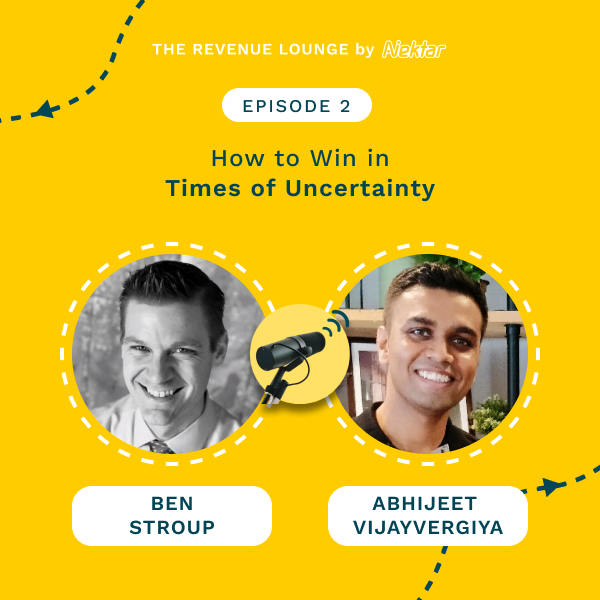
Ep #2: How to Win in Times of Uncertainty
Listen Now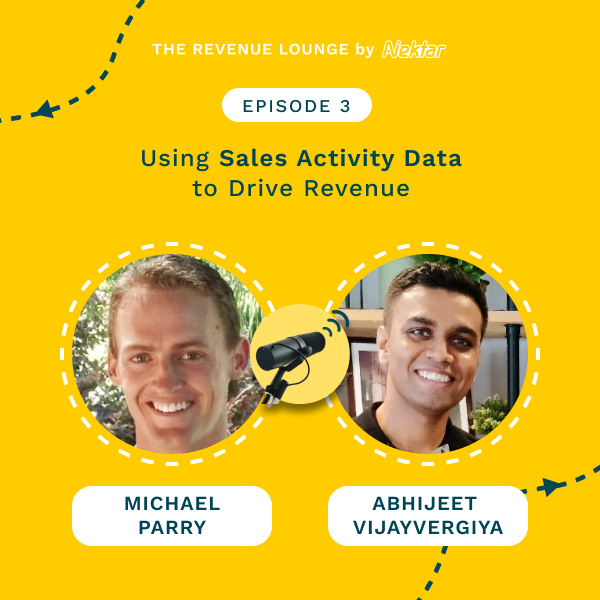
Ep #3: Using Activity Data to Drive Sales Productivity
Listen Now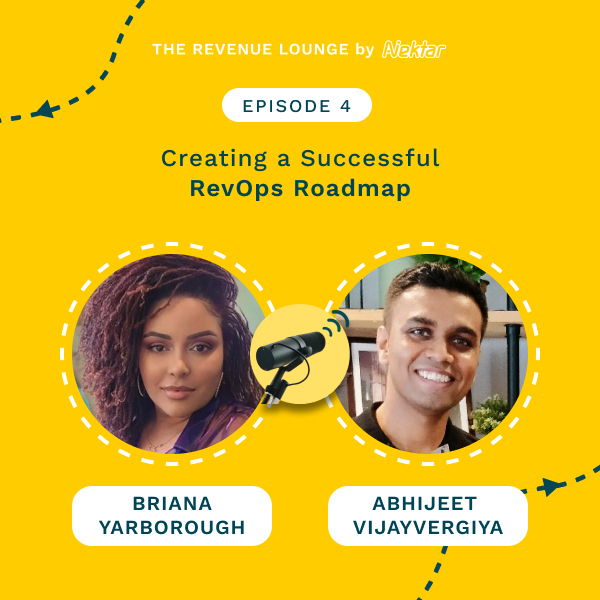
Ep #4: Creating a Successful RevOps Roadmap
Listen Now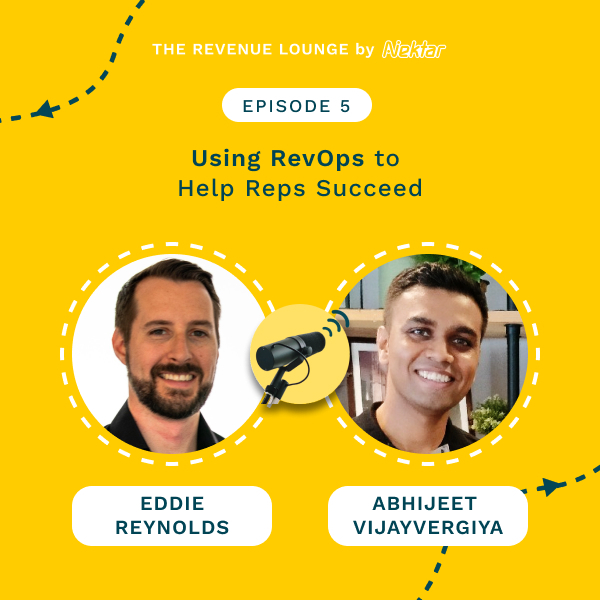
Ep #5: Using RevOps to Help Reps Succeed
Listen Now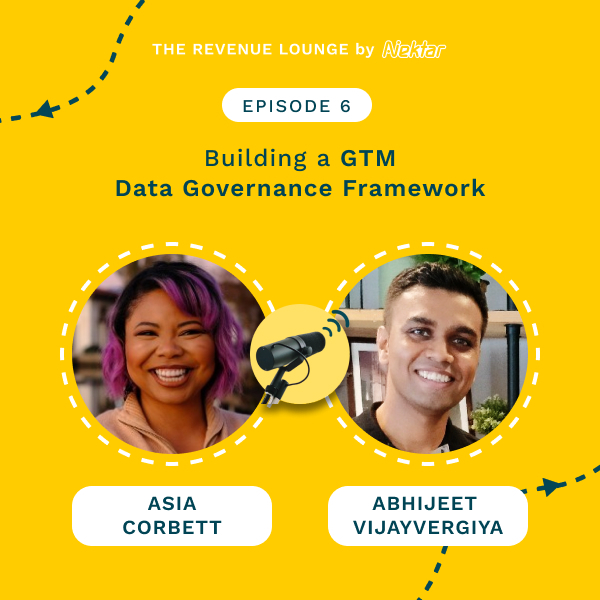
Ep #6: Building a GTM Data Governance Framework
Listen Now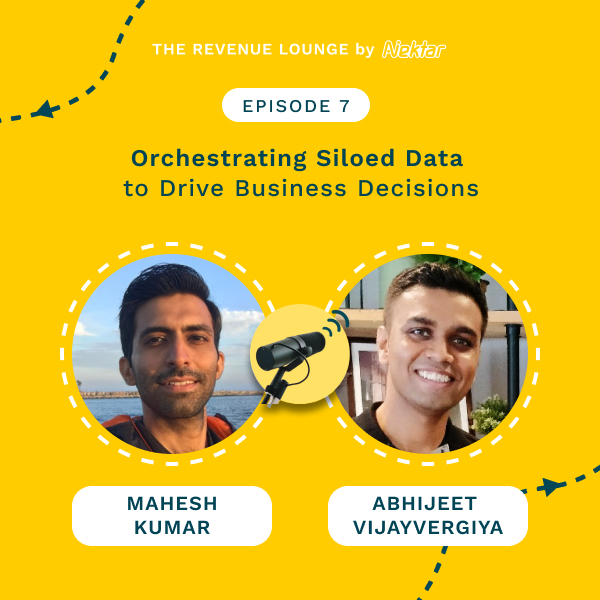
Ep #7: Orchestrating Siloed Data to Drive Business Decisions
Listen Now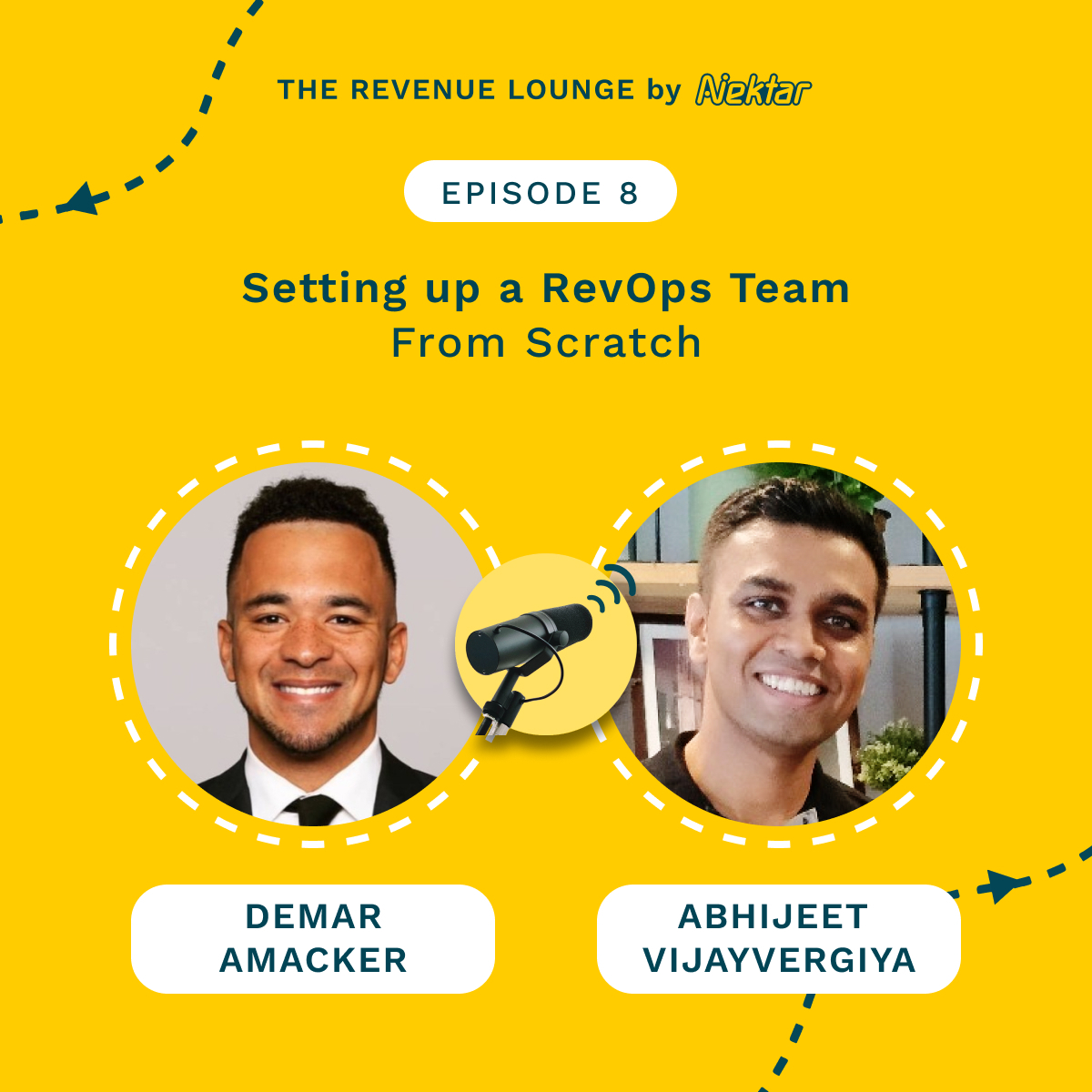
Ep #8: Setting Up a RevOps Team From Scratch
Listen Now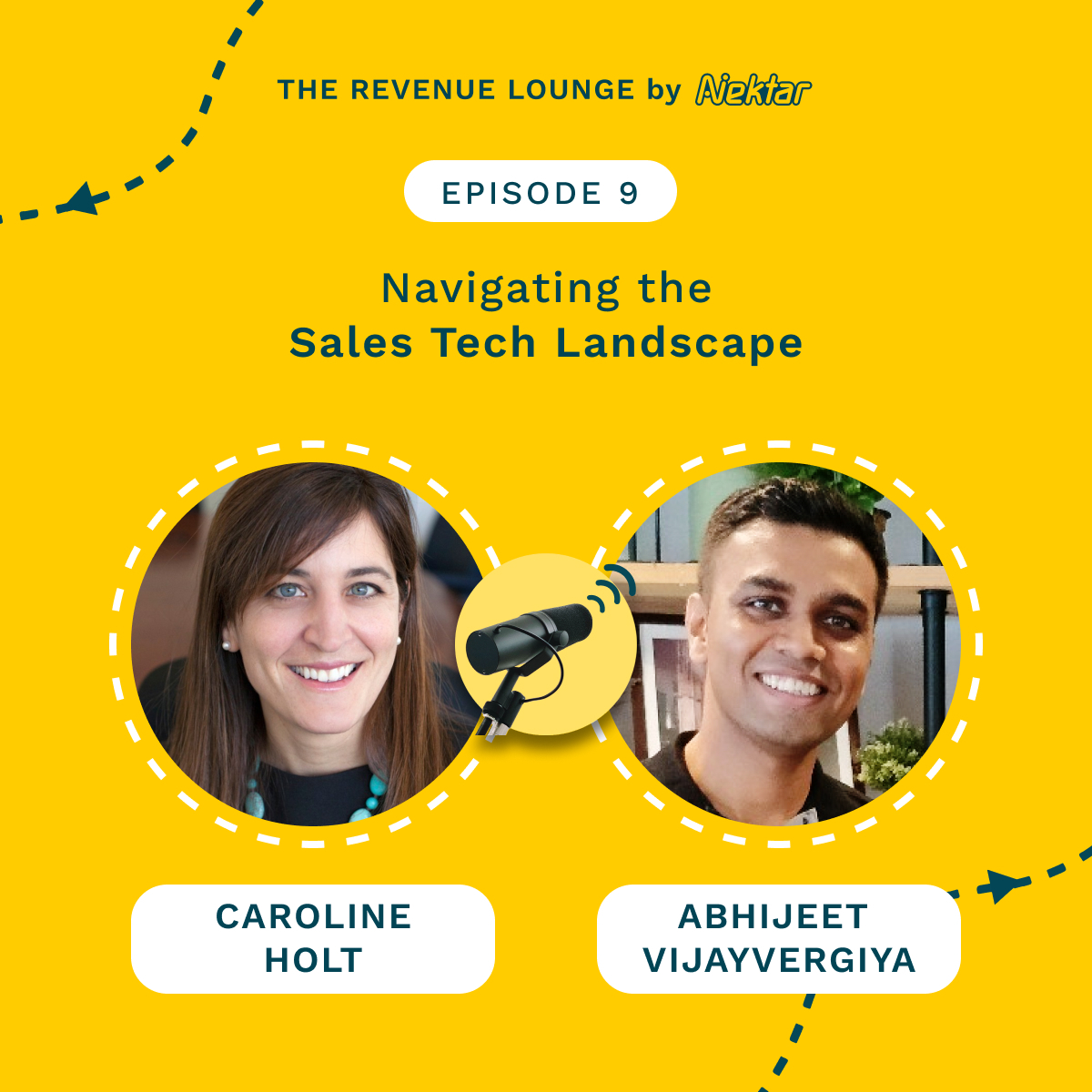
Ep #9: Navigating the Sales Tech Landscape
Listen Now